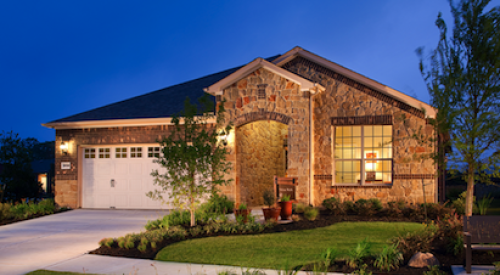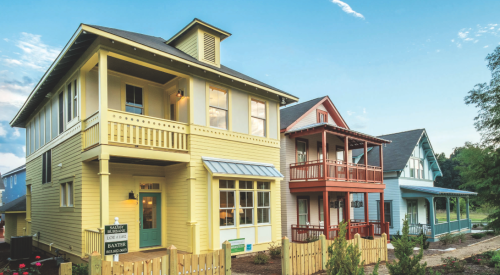New Urbanism flourishes in pockets of development around the country and recently took root in the town of O'Fallon, west of St. Louis. There, within a 1,100-acre master plan called WingHaven, four of 27 residential villages were set aside for traditional neighborhood design. At Sleepy Hollow Village, a TND-designated neighborhood of 104 detached single-family homes, builder The Jones Co. of Chesterfield, Mo., proved that Neo-Traditional design meets the demand for affordable/work force housing.
|
Neo-Traditional gingerbread brings the 19th century to life in conventionally framed, vinyl-sided homes like this Addison model. The market-affordable homes of Boardwalk Place at WingHaven have more details than some of the builder's more upscale homes.
Photo: Alise O'Brien |
|
|
Go upstairs in the Addison, the smallest and most affordable of seven plans, and find out what makes an affordable kitchen work. Future upgrades to the laminate countertops and linoleum flooring will benefit from solid construction and an efficient flow.
|
|
|
|
|
This optional study replaces a fourth bedroom in the Endicott, the largest home of this compact line at 2,080 square feet.
|
|
|
The Endicott (foreground) and Larkspur (background) were top sellers. They are the largest plans in the collection. Both have first-floor masters.
See the Larkspur floorplan |
|
|
Smart dentil work and porch colonnade lend an established air to this Winslow Elevation 2, belying its diminutive 1,532-square-foot size. The interior packs a compact punch as well. Options include a vaulted master bedroom ceiling, luxury bath, entertainment center, pantry and more windows.
|
|
|
In addition to first-floor masters, the Endicott and Larkspur were the only two plans with a full 20x20-foot storage/bonus room above the two-car garage - a nod to move-up buyers missing basements in The Jones Co.'s first slab construction foray. An additional second-floor bonus room of 15.8x14.6 square feet was another option created by sacrificing one of four bedrooms and opening it to the second-floor hallway.
|
Opportunities
The Jones Co., a division of Centex Homes, was one of four companies already building elsewhere in WingHaven, which broke ground in 1998 with a full mix of rental, attached and detached housing. The Jones Co. saw the Boardwalk area of WingHaven as ideal for serving an overlooked demographic of first-time buyers, mostly renters ages 20 to 30. Affordable homeownership would lure them with mortgage interest tax deductions and a chance to build equity at a time when securities markets were weak and mortgage rates low.
Secondary targets included first move-up buyers and empty nesters downscaling to afford a second home in another market.
"We knew if we put this product line in, we would be doing a service to the community, and we would bring repeat buyers into our marketing organization," says Melody Kuehl, area sales manager.
Obstacles
Research showed that buyers wanted maximum square footage of livable space. To keep prices down, the builder abandoned basement foundations, a risky move because in St. Louis, buyers traditionally prefer homes with basements.
"Our research pretty much showed slab construction versus basements would sell, but this was our first time doing slab," says division president Ken Stricker. "We were not totally sure it would work here. After all, we are in the 'Show Me' state."
Nonetheless, the company reasoned that first-time and second-home buyers have less need for basements than larger families, Kuehl says, "because most of these homebuyers were moving from an apartment or were downsizing. They either didn't have a lot of items to store or were getting rid of items that they had to store." Those who wanted more space could create larger-volume areas by removing walls or opt for space-maximizing details such as tucking a TV niche underneath a stairway.
Ultimately, the sales team overcame potential objections by emphasizing the standard two-car garages and the op-tional 20x20-foot bonus/storage rooms above the garage in the two largest plans.
Balancing price, size and living space is a misunderstood art, says architect Barry Glantz, president of Glantz & Associates in St. Louis. "The size of the project does not have to dictate the quality of the design," he explains. "On this project, every inch counted. We had lower square footage and a lower price point, and we had to be very creative about how we designed those spaces." For instance, in the smallest plan, the kitchen is on the second floor, and two of the larger floorplans feature first-floor master bedrooms.
This variety helps differentiate the product line's seven different plans and helped meet the challenge of differentiating exterior elevations. Glantz created two or more front elevation designs per plan and avoided a visual cookie-cutter look with details on front porches, windows and roof gables.
As a result, says Kuehl, "the front elevations on Boardwalk Place homes have more detail than some of our higher-priced product lines."
Rear-loaded garages accessed by alleys banished driveways from view to further enhance the streetscape. A homeowners' association maintains the alleys along with public open spaces and other common amenities.
Outcome
"Any new construction technique or product line makes a builder nervous," Stricker says. "But once we opened, we knew right away that it was going to be successful. Traffic through the models was just phenomenal." The company closed 30 sales in its first month and averaged 300 to 400 shoppers through the sales office for many more months. All 104 homes sold in two years.
The two largest plans with the highest price tag were the top sellers and were the only homes with full above-garage bonus space options and first-floor masters. These plans found broad appeal among young professionals, some of whom converted the first-floor master to an office; unmarried buyers with roommates; and extended families. "Surprisingly, we saw a lot people moving their parents or grandparents into their new homes," says Kuehl.
Home prices appreciated more than $15,000 over the course of buildout, a boon to buyers and still affordable. Prices were between $128,400 to $147,400 at the start of sales, but eventually ranged from $144,200 to $163,000, with upgrades taking homes into the $190s.
Stricker confirms that some of these home plans will be used at Carlton Glen, approximately 7 miles west in Wentzville, Mo. In turn, the overall community's success inspired at least two more Neo-Traditional master plans in the surrounding area.












